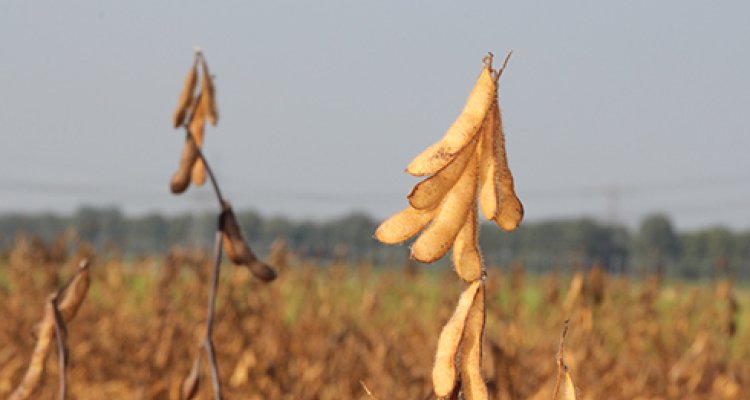
FAQ
How do you cultivate soya in the Netherlands?
What is soya? How do you cultivate this crop in the Netherlands? Do you need to use fertilisers and what is the yield per hectare? On this page you’ll find questions and answers relating to soya.
What is soya?
The soya plant belongs to the legume family. Legume crops that are better known in the Netherlands include peas, broad beans, lucerne (also known as alfalfa) and lupin. The roots of all legumes form what are called nitrogen nodules, allowing them to use nitrogen from the atmosphere to satisfy their own nitrogen requirements. Soya plants produce pods containing small beans. The protein content of these beans is very high (35-40%) and the quality of the protein is excellent. After extracting oil from the beans, an extremely protein-rich substance remains, which is then used to make animal feed.
Can you cultivate soya in the Netherlands?
It is possible to cultivate soya plants in the Netherlands but they have to be varieties adapted to the north-west European climate. Soya beans were cultivated on a small scale in the Netherlands during the 1930s but that did not prove very successful. Since then there have been various other attempts, but soya cultivation remained at the level of experimentation until a few years ago. A few suitable varieties became available which gave a good yield and ripened quickly enough under Dutch conditions. The soya cultivated in the Netherlands is referred to as ‘Nethersoya’.
Is organic soya grown in the Netherlands?
It is also possible to grow soya beans organically in the Netherlands. Because soya has its own source of nitrogen, the crop is interesting for organic farmers. The only drawback is that weed control can be time-consuming because soil has to be kept weed-free by hoeing. A few Dutch organic farms are now including soya in their cultivation plan.
Is soya bred in the Netherlands and which soya varieties can you cultivate in the Netherlands?
Soya breeding does occur in the Netherlands but only on a very small scale as it is not important enough for the larger plant breeding companies to consider starting up a breeding programme. In the Netherlands, we are therefore interested in the range of varieties available from other European countries (Germany, France, Austria and Switzerland) where much more attention is paid to breeding soya. The number of varieties suitable for Dutch cultivation is still extremely limited, but perhaps the variety trials now being carried out will soon add to this number. Adsoy and Sunrise are two of the varieties being bred in the Netherlands. Adsoy in particular produces quite good yields and is being used by almost all the Dutch growers. None of the soya varieties grown in the Netherlands and other European countries are genetically modified (they are non-GMO).
When do you sow and when do you harvest?
Soya is susceptible to night frosts, so it cannot be sown too early; between 20 April and 5 May is recommended. Sowing is also possible until the middle of May but the greater the delay, the later the crop ripens. If sowing takes place at the end of April, harvesting is usually possible during the last few days of September; if you sow any later, it will be October before the crop is ready for harvesting.
How do you harvest soya?
Soya is harvested with the same combine harvester as is used for grain crops. It is important to ensure the crop has died off sufficiently (is completely brown), and that pods and seeds are sufficiently dry (20% moisture or less). Even so, Dutch soya beans usually have to be dried after harvesting.
How do you control weeds?
Soya is sown in rows 25-35 cm apart. This makes it possible to hoe between the rows and remove weeds. Within the rows, weeds have to be removed by hand or with a cutting hoe. These mechanical methods of weed control are mostly used on organic farms. Traditional farms can also apply herbicides or other forms of crop protection. A few soil and contact herbicides have been approved for use in soya cultivation.
Which diseases occur in soya and what is the best way of controlling them?
Various moulds can attack soya but so far in the Netherlands only Sclerotinia has been discovered at a level that is damaging to the crop. This fungus can cause patches of infestation, leading to early death of the soya bean plants and affecting yields. Sclerotinia occurs especially under wet conditions. Some crop protection agents have been approved for controlling Sclerotinia. Being preventative agents, they need to be used before the disease becomes visible. Certain nematodes can also attack soya, but this is not yet confirmed. Is research being done on this?
Do you need to use fertilisers on soya bean crops?
Just like any other crop, soya needs sufficient nitrogen, phosphate, potassium and certain trace elements if it is to grow and yield well. Soya is a legume and therefore has root nodules in which the Bradyrhizobium japonicum bacteria work in symbiosis with the plant, capturing nitrogen from the atmosphere, and thus supplying most of the plant’s nitrogen requirements. So far, nitrogen fertilisers have not produced higher yields or a higher protein content. Because the requirement for phosphate and potassium is limited, fertilisers are not necessary if there is a sufficient supply of these elements present in the soil.
What are the economic aspects?
At present the cultivation of soya in our country can compete with, for example, that of summer grains. However, it is expected that higher yields will be possible. It is hoped that research will lead to yield increases: from the present 3 tonnes per hectare to 4 tonnes over the next few years. Then, soya will also be able to compete with winter grains and other crops.